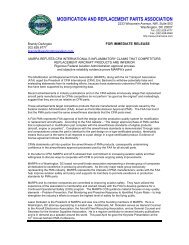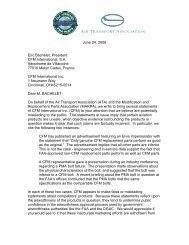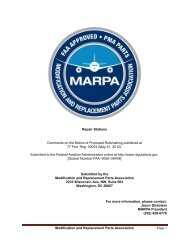February 9, 2013 MARPA files comments on FAA Draft Order 8900.1 ...
February 9, 2013 MARPA files comments on FAA Draft Order 8900.1 ...
February 9, 2013 MARPA files comments on FAA Draft Order 8900.1 ...
- No tags were found...
You also want an ePaper? Increase the reach of your titles
YUMPU automatically turns print PDFs into web optimized ePapers that Google loves.
Who is <str<strong>on</strong>g>MARPA</str<strong>on</strong>g>?The Modificati<strong>on</strong> and Replacement Parts Associati<strong>on</strong> was founded to support PMAmanufacturers and their customers. Aircraft parts are a vital sector of the aviati<strong>on</strong> industry, and<str<strong>on</strong>g>MARPA</str<strong>on</strong>g> acts to represent the interests of the manufacturers of this vital resource before the<strong>FAA</strong> and other government agencies.<str<strong>on</strong>g>MARPA</str<strong>on</strong>g> is a Washingt<strong>on</strong>, D.C.-based, n<strong>on</strong>-profit associati<strong>on</strong> that supports its members’business efforts by promoting excellence in producti<strong>on</strong> standards for PMA parts. TheAssociati<strong>on</strong> represents its members before aviati<strong>on</strong> policy makers, giving them a voice inWashingt<strong>on</strong> D.C. to prevent unnecessary or unfair regulatory burden while at the same timeworking with aviati<strong>on</strong> authorities to help improve the aviati<strong>on</strong> industry’s already-impressivesafety record.Although <str<strong>on</strong>g>MARPA</str<strong>on</strong>g> members typically rely <strong>on</strong> designees with Aircraft Certificati<strong>on</strong> privileges, theyoften sell parts through distributors who must rely <strong>on</strong> Flight Standards designees to performservices like issuing 8130-3 tags for export purposes. In fact, many PMA holders do not havethe infrastructure to issue 8130-3 tags for their parts, and so when a distributor exports thoseparts to a nati<strong>on</strong> that enjoys a bilateral airworthiness safety agreement with the United States,that distributor must obtain the 8130-3 tag from a DAR (typically a Flight Standards ServiceDAR or DAR-T). For this reas<strong>on</strong>, DAR-T guidance is very important to <str<strong>on</strong>g>MARPA</str<strong>on</strong>g> members.CommentsGeographic Expansi<strong>on</strong> within the United StatesIssueThe draft guidance proposes significant new instructi<strong>on</strong>s for managing DAR applicati<strong>on</strong>s toperform work outside the geographic boundaries of their managing office, while remaining insidetheir geographic regi<strong>on</strong>. The proposed guidance would establish a standard that wouldeffectively preclude DARs from obtaining permissi<strong>on</strong> to work outside of the geographicboundaries of his or her managing office.The proposed language states that when a DAR applies for permissi<strong>on</strong> to work outside thegeographic boundaries of the managing office: “The geographically resp<strong>on</strong>sible office [in whichthe proposed activity will occur] should deny the request when a local inspector or designee canaccomplish the work.” Proposed § 13-409(A)(2).AnalysisBecause every geographic regi<strong>on</strong> has DARs that are capable of issuing 8130-3 tags, it istechnically always possible for a local DAR to perform work in a proposed regi<strong>on</strong>. The proposedguidance can therefore be used in every case as a justificati<strong>on</strong> for denying an applicati<strong>on</strong> forgeographic expansi<strong>on</strong>. Creating an “automatic no” in the guidance undermines the safetymissi<strong>on</strong> that DARs perform.Modificati<strong>on</strong> and Replacement Parts Associati<strong>on</strong> Page 3
This proposed language would effectively preclude DARs from competing with other DARs inother regi<strong>on</strong>s. Competiti<strong>on</strong> is already limited by the small number of DARs that are eligible andavailable to issue 8130-3 tags for parts held by the industry. By further limiting competiti<strong>on</strong>, thenatural result would be for patterns to emerge which cause pricing of DAR services to rise tom<strong>on</strong>opolistic or oligopolistic levels. Current charges for DAR services are already out-of-linewith costs for government services.<strong>FAA</strong> employees are generally precluded from issuing 8130-3 tags for aircraft parts under therestrictive terms of <strong>FAA</strong> <strong>Order</strong> 8130.21G, see <strong>Order</strong> 8130.21G, Procedures for Completi<strong>on</strong> andUse of the Authorized Release Certificate, <strong>FAA</strong> Form 8130-3, Airworthiness Approval Tag § 1-8,but the <strong>FAA</strong> has made these tags generally necessary for both domestic and internati<strong>on</strong>alcommerce (for example, <strong>FAA</strong> bilateral aviati<strong>on</strong> safety agreements have committed to provisi<strong>on</strong>of these tags with US exports of aircraft parts). This means that <strong>FAA</strong> policy and executiveagreements have made it commercially necessary to hire DARs to issue 8130-3 tags fordem<strong>on</strong>strably airworthy parts. By introducing policies that encourage m<strong>on</strong>opolistic oroligopolistic pricing levels, the <strong>FAA</strong> is doing a disservice to the U.S. industry. In additi<strong>on</strong>, the<strong>FAA</strong> is creating m<strong>on</strong>opolies or oligopolies in situati<strong>on</strong>s where the <strong>FAA</strong> lacks statutory authorityto create such limits <strong>on</strong> competiti<strong>on</strong>. Normally, if an agency has authority to limit competiti<strong>on</strong> orto permit combinati<strong>on</strong>s in restraint of trade, such authority will be explicit. Cf. 15 U.S.C. § 17(exempting labor uni<strong>on</strong>s from the antitrust provisi<strong>on</strong>s of the Sherman Act and effectivelyoverturning Loewe v. Lawlor, 208 U.S. 274 (1908) which had held that collective acti<strong>on</strong> by uni<strong>on</strong>members violated the antitrust law known as the Sherman Act).Rather than following an “automatic no” policy, the <strong>FAA</strong> should encourage available DARs in ageographic regi<strong>on</strong> to perform work bey<strong>on</strong>d the boundaries of their managing office. Allowingcompetiti<strong>on</strong> between DARs will benefit the industry by reducing delays for approvals andlowering the costs of DAR services.Recommendati<strong>on</strong>Delete the instructi<strong>on</strong>: “The geographically resp<strong>on</strong>sible office should deny the request when alocal inspector or designee can accomplish the work.” By eliminating the “automatic no” the<strong>FAA</strong> will encourage competiti<strong>on</strong> and increase efficiency within the industry. It will also avoidtaking a step through policy that it would likely be precluded from taking through regulati<strong>on</strong>.Applicant C<strong>on</strong>venience and Internati<strong>on</strong>al Geographic Expansi<strong>on</strong>IssueThe proposed guidance includes new instructi<strong>on</strong>s for managing DAR applicati<strong>on</strong>s to performwork outside of the United States. One of the proposed instructi<strong>on</strong>s would require the designeeto adequately identify the reas<strong>on</strong> for the performance of the activity outside of the United States,but goes <strong>on</strong> to state that “[a]pplicant c<strong>on</strong>venience is not an adequate reas<strong>on</strong>.” Proposed § 13-409(B)(2)(e).Modificati<strong>on</strong> and Replacement Parts Associati<strong>on</strong> Page 4
AnalysisIn 2007, the <strong>FAA</strong> published a rule change to 14 C.F.R. § 21.325 to permit issue of an 8130-3tag outside the United States. See Producti<strong>on</strong> and Airworthiness Approvals, Part Marking, andMiscellaneous Proposals, 72 Fed. Reg. 63797 (Nov. 13, 2007) (Final Rule). This was d<strong>on</strong>ebecause it was more c<strong>on</strong>venient for certain types of internati<strong>on</strong>al transacti<strong>on</strong>s, and the <strong>FAA</strong> hadgranted a number of exempti<strong>on</strong>s in the past that allowed export airworthiness approvals to beissued for products located in other countries. See Producti<strong>on</strong> and Airworthiness Approvals,Part Marking, and Miscellaneous Proposals, 71 Fed. Reg. 58914, 58928 (Oct. 5, 2006) (Noticeof proposed Rulemaking). The proposed guidance would undermine this 2007 rule change byproposing language that reads: “The designee has adequately identified the specific reas<strong>on</strong>s forthe performance of this activity outside the United States. Applicant c<strong>on</strong>venience is not anadequate reas<strong>on</strong>.” Proposed § 13-409(B)(2)(e) (emphasis added).Applicant c<strong>on</strong>venience is, in fact, the real justificati<strong>on</strong> for the rule change (combined with afinding that applicant c<strong>on</strong>venience does not undermine <strong>FAA</strong> safety goals). The followingscenario provides an example.Assume there is a large inventory of aircraft parts in a foreign nati<strong>on</strong>. Each of these parts is welldocumented with traceability that makes it clear that they were produced under United Statesproducti<strong>on</strong> approval, but the parts do not have <strong>FAA</strong> 8130-3 tags. The documents that do existmake it easy to issue the 8130-3 tags. The problem is that the inventory is significant and it islocated outside of the United States. Although it would be possible to return the entire inventoryto the United States for <strong>FAA</strong> 8130-3 tags, it would be ec<strong>on</strong>omically impractical. Approving anapplicati<strong>on</strong> for a DAR to review the parts and issue 8130-3 tags outside of the United States isboth more practical and more c<strong>on</strong>venient. Thus, applicant c<strong>on</strong>venience should be a validrati<strong>on</strong>ale for internati<strong>on</strong>al geographic expansi<strong>on</strong>, as l<strong>on</strong>g as the internati<strong>on</strong>al geographicexpansi<strong>on</strong> does not impose an undue burden <strong>on</strong> the <strong>FAA</strong>.Recommendati<strong>on</strong>Delete the instructi<strong>on</strong>: “Applicant c<strong>on</strong>venience is not an adequate reas<strong>on</strong>.” Such language is indirect c<strong>on</strong>flict with the rulemaking purpose behind the change to 14 C.F.R. § 21.325.Inappropriate Use of the Term “Principal Inspector”IssueThe guidance uses the term “Principal Inspector” or “PI” to refer to the <strong>FAA</strong> employee with directsupervisi<strong>on</strong> of the DAR. See, e.g., proposed 13-409(A)(1); 13-438(A). This appears to be aninadvertent misuse of the term in situati<strong>on</strong>s where the correct term should have been “<strong>FAA</strong>Advisor.”AnalysisNorms in the industry, as well as existing usage in <strong>FAA</strong> <strong>Order</strong> 8100.8D, use the term “PrincipalInspector” or “PI” to reference the <strong>FAA</strong> employee with direct oversight over a certificated facility.Modificati<strong>on</strong> and Replacement Parts Associati<strong>on</strong> Page 5
See, e.g., <strong>Order</strong> 8100.8D, Designee Management Handbook at § 902(b)(3). The term “<strong>FAA</strong>advisor” is generally used in reference to the <strong>FAA</strong> employee with direct supervisi<strong>on</strong> of a DAR.Notably, “<strong>FAA</strong> advisor” is the term used in <strong>Order</strong> 8100.8D. See id. at Appendix H.Allowing multiple definiti<strong>on</strong>s of terms and ambiguity about the meaning of terms is an <strong>on</strong>goingsource of frustrati<strong>on</strong> in the industry. When a known and comm<strong>on</strong> use is used to mean <strong>on</strong>e thing—such as in the case of “Principal Inspector” which is comm<strong>on</strong>ly understood to mean acertificated entity’s principle assigned <strong>FAA</strong> aviati<strong>on</strong> safety inspector —care should be taken toremain c<strong>on</strong>sistent in that usage to avoid possible c<strong>on</strong>fusi<strong>on</strong> in the industry.Furthermore, using the term “Principal Inspector” risks specific c<strong>on</strong>fusi<strong>on</strong> in the c<strong>on</strong>text of theguidance in questi<strong>on</strong>. In cases where the client of the designee is a certificated entity that has aprincipal inspector who is a different pers<strong>on</strong> from the <strong>FAA</strong> employee who serves as the <strong>FAA</strong>Advisor of the designee, there is the potential for c<strong>on</strong>fusi<strong>on</strong> as to which principle inspector isintended by the use of the term in the guidance.. For example, where a designee is seekingexpanded geographic authority in order to issue export 8130-3 for an air carrier of repair stati<strong>on</strong>seeking issuance of 8130-3 tags for export articles from a remote inventory, the term “principleinspector” typically refers to the principle ASI for the certificate holder, but proposed secti<strong>on</strong> 13-409(A)(1) suggests using the same terminology for the designee’s <strong>FAA</strong> Advisory.Recommendati<strong>on</strong>The term “Principal Inspector” or “PI” should be replaced with “<strong>FAA</strong> Advisor” when referring tooversight of a designee, to remain c<strong>on</strong>sistent with existing <strong>FAA</strong> guidance, as well as withcomm<strong>on</strong> <strong>FAA</strong> use of these two terms.C<strong>on</strong>clusi<strong>on</strong><str<strong>on</strong>g>MARPA</str<strong>on</strong>g> looks forward to working with the <strong>FAA</strong> to better improve aviati<strong>on</strong> safety rules and policy.Your c<strong>on</strong>siderati<strong>on</strong> of these <str<strong>on</strong>g>comments</str<strong>on</strong>g> is greatly appreciated.Respectfully Submitted,Jas<strong>on</strong> DicksteinPresidentModificati<strong>on</strong> and Replacement Parts Associati<strong>on</strong>Modificati<strong>on</strong> and Replacement Parts Associati<strong>on</strong> Page 6








